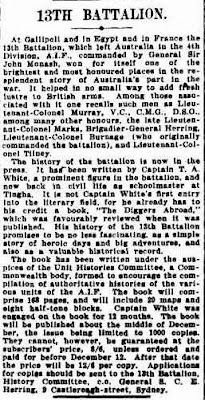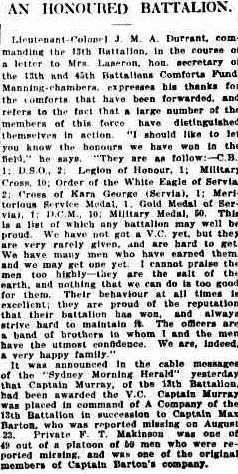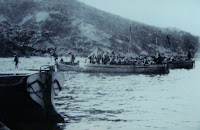The video presentation 'Charles Bean's Great War' is a dramatised documentary by 360 Degree Films. It offers an indepth visual record of the life of Charles Bean throughout his civil and military life.
Click here to see more details about
Charles Bean Great War Military DVD.
Charles Edwin Woodrow Bean was born on the 18
th November 1879 at
Bathurst, New South Wales.
Bean’s
family already had military connections, in that his Grandfather was
Surgeon-Major in the army of the East India Company. In 1889, Bean’s family
(due to his Father’s ill health) moved back to England, which afforded Charles
a great opportunity for education. He was fortunate to gain a scholarship to
study the Arts and then Law at Hertford College Oxford. Having completed his
education, he returned to Australia in 1904 where he was admitted to the New
South Wales Bar.
Bean preferred writing to being a lawyer. In 1907 he wrote a book,
‘Impressions of a New Chum’ it was never published as a single volume but the
Sydney Morning Herald published some parts. He found a friend in Banjo
Patterson who advised him to go and work at the Herald. So in 1908, Bean joined
the Sydney Morning Herald as a junior Journalist.
This change would make a
monumental difference to the rest of his life.
In this early period, he had
success in publishing several books,
With the Flagship in the South
(London, 1909)
On the Wool Track (London, 1910)
The Dreadnought of
the Darling (London, 1911) and
Flagships Three (London, 1913). Many
of these books had a military theme and he had become very well known for his
newspaper articles connected to the escalating conflict in Europe.
At the onset of World War One the British Government asked the dominions to
nominate an Official Correspondent to their Contingent.
The selection of Australia’s Correspondent
was to be decided by the Australian Journalists Association. They decided to
conduct a ballot to select who would become the official correspondent with the AIF.
It’s interesting, that Charles Bean narrowly won the position from Keith
Murdoch, their paths would cross many times in the coming years.
Bean sailed with the first Australian Contingent to Egypt in 1914.
He was a first day
lander at Gallipoli where he took some of the first photographs of the action
at Anzac Cove. To Bean’s annoyance and frustration the British authorities held his reports of
the landings until
13th May 1915. This allowed the English correspondent,Ellis
Ashmead-Bartlett to make the first Australian Newspaper reports of the famous
25
th April 1915 landings.
During the 1
st week in May,
Charles Bean accompanied the Australian 2
nd Infantry Brigade and the
New Zealand Infantry Brigade south to Helles so that they could take part in
the Second Battle of Krithia. He proved himself courageous in the front line at
Krithia when he helped wounded infantry off the battlefield. He was actually
recommended for the Military Cross medal but was denied the award when it was
deemed that he was a civilian.
During the August Offensives, on the 6th August a stray bullet hit him in his
right leg. He refused to leave Anzac nor to have the bullet removed so he lay
in his dugout for three weeks while his wound healed. The bullet remained in his
leg the rest of his life.
He was the
only correspondent to remain at Gallipoli for the entire time of the occupation
from the landing to the evacuation.
During the Gallipoli Campaign he edited
The Anzac Book (London, 1916),
which was a collection of Australian digger trench stories and cartoons. It was
published in 1916, the proceeds to benefit returned soldiers. The book is very popular
to this day and was recently reprinted in its third edition by the Australian
War Memorial.
Bean continued his reporting during the period 1916-1918. Throughout the Western Front he made himself present at most of the major
Battles undertaken by the AIF. Most importantly, he conceived an idea of
a memorial to the Australian fallen and he established his War Records Unit which
was to collect battlefield relics and
memorabilia from the various Battles.
He continued to publish, Letters from France (London, 1917) and In Your Hands, Australians (London,
1918).
After the war his first passion was not to return to Australia but to go back
to Gallipoli to make a study of that Battle location. His adventure was latter
published in his book Gallipoli Mission (Canberra, 1948).
He returned to Australia where in latter 1919 he took up residence at the
homestead at Tuggeranong near Canberra. There he was to create the monumental The
Official History of Australia in the War of 1914-1918 from his many
hundreds of wartime diaries, notes, memory and soldier related information.
In 1921, he married Ethel Young with whom he had played tennis at
Tuggeranong.
At the start of World War 2 he wrote a pamphlet, The Old A.I.F and the New
(Sydney, 1940). Bean was instrumental in the development and construction of
the Australian War Memorial which opened in 1941.
One of his last major works was the one-volume abridgement of the The
Official History of Australia in the War of 1914-1918 which he titled
Anzac to Amiens (Canberra, 1946).
His last book was a dedication to two men
that he had admired during his AIF days. He titled the book, Two Men I Knew.
William Bridges and Brudenell White Founders of the A.I.F. (Sydney, 1957)
In latter years he held senior positions with the ABC.
He died in 1968 at Concord Repatriation General Hospital
aged 88.
 During these early times, Australians displayed much enthusiasm for the war. A 2000 strong Force which was to be called Australian Naval and Military Expeditionary Force (ANMEF) was quickly assembled from the large number of volunteers. In Sydney, 1000 men mostly with prior military service made up the 1st Battalion of the ANMEF. A further 500 naval reservists and 500 militia volunteers from the Kennedy Regiment North Queensland, two machine-gun sections, a signalling section, and a detachment of the Australian Army Medical Corps completed the force. The fledgling Australian Navy supplied a flotilla of ships which included the AE1 and AE2 Submarines.
During these early times, Australians displayed much enthusiasm for the war. A 2000 strong Force which was to be called Australian Naval and Military Expeditionary Force (ANMEF) was quickly assembled from the large number of volunteers. In Sydney, 1000 men mostly with prior military service made up the 1st Battalion of the ANMEF. A further 500 naval reservists and 500 militia volunteers from the Kennedy Regiment North Queensland, two machine-gun sections, a signalling section, and a detachment of the Australian Army Medical Corps completed the force. The fledgling Australian Navy supplied a flotilla of ships which included the AE1 and AE2 Submarines.











 Lt.
Joseph Maxwell, M.C., D.C.M., 18th Bn., A.I.F. For most conspicuous
bravery and leadership in attack on the Beaurevoir-Fonsomme line near
Estates, North of St. Quentin, on the 3rd October, 1918. His company
commander was severely wounded early in the advance, and Lt. Maxwell at
once took charge. The enemy wire when reached under intense fire was
found to be exceptionally strong and closely supported by machine guns,
whereupon Lt. Maxwell pushed forward single-handed through the wire and
captured the most dangerous gun, killing three and capturing four enemy.
He thus enabled his company to penetrate the wire and reach the
objective. Later, he again dashed forward and silenced, single-handed, a
gun which was holding up a flank company. Subsequently, when with two
men only he attempted to capture a strong party of the enemy, he handled
a most involved situation very skilfully, and it was due to his
resource that he and his comrades escaped. Throughout the day Lt.
Maxwell set a high example of personal bravery, coupled with excellent
judgment and quick decision.
Lt.
Joseph Maxwell, M.C., D.C.M., 18th Bn., A.I.F. For most conspicuous
bravery and leadership in attack on the Beaurevoir-Fonsomme line near
Estates, North of St. Quentin, on the 3rd October, 1918. His company
commander was severely wounded early in the advance, and Lt. Maxwell at
once took charge. The enemy wire when reached under intense fire was
found to be exceptionally strong and closely supported by machine guns,
whereupon Lt. Maxwell pushed forward single-handed through the wire and
captured the most dangerous gun, killing three and capturing four enemy.
He thus enabled his company to penetrate the wire and reach the
objective. Later, he again dashed forward and silenced, single-handed, a
gun which was holding up a flank company. Subsequently, when with two
men only he attempted to capture a strong party of the enemy, he handled
a most involved situation very skilfully, and it was due to his
resource that he and his comrades escaped. Throughout the day Lt.
Maxwell set a high example of personal bravery, coupled with excellent
judgment and quick decision.




 A 6th
Battlion hero of the 2nd attack was Captain Alf Jackson his CO
recommended Jackson for a posthumous bravery award which was never
awarded the citation read,”He worked well in a dark underground
tunnel organizing and when the advance commenced by his fearless bravery
helped the men forward under heavy fire. Even after he was hit,he
continued his work until his leg was very badly smashed"
A 6th
Battlion hero of the 2nd attack was Captain Alf Jackson his CO
recommended Jackson for a posthumous bravery award which was never
awarded the citation read,”He worked well in a dark underground
tunnel organizing and when the advance commenced by his fearless bravery
helped the men forward under heavy fire. Even after he was hit,he
continued his work until his leg was very badly smashed"